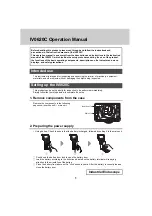
6
EN
BE20
English
en
Safety
Read this manual carefully before starting or using the device. Always
store the manual in the immediate vicinity of the device or its site of use.
Warning
Read all safety warnings and all instructions.
Failure to follow the warnings and instructions may result in electric
shock, fire and / or serious injury.
Save all warnings and instructions for future reference.
•
Do not use the device in potentially explosive rooms or areas and do not
install it there.
•
Do not use the device in aggressive atmosphere.
•
Protect the device from permanent direct sunlight.
•
Do not remove any safety signs, stickers or labels from the device. Keep
all safety signs, stickers and labels in legible condition.
•
Do not open the device.
•
Never charge batteries that cannot be recharged.
•
Different types of batteries and new and used batteries must not be
used together.
•
Insert the batteries into the battery compartment according to the
correct polarity.
•
Remove discharged batteries from the device. Batteries contain
materials hazardous to the environment. Dispose of the batteries
according to the national regulations.
•
Remove the batteries from the device if you will not be using the device
for a longer period of time.
•
Never short-circuit the supply terminal in the battery compartment!
•
Do not swallow batteries! If a battery is swallowed, it can cause severe
internal burns within 2 hours! These burns can lead to death!
•
If you think batteries might have been swallowed or otherwise entered
the body, seek medical attention immediately!
•
Keep new and used batteries and an open battery compartment away
from children.
•
The device is only designed to display the voltage range and is not
suitable for measuring purposes.
•
Immediately before and after each use, test the voltage detector for
proper functioning. The voltage detector must not be used if one or
several indications on the voltage detector fail or if the functionality of
the device cannot be clearly recognized.
•
The voltage detector may only be used within the specified rated
voltage range and in electrical installations of up to 400 V AC and
690 V DC.
•
The voltage detector may only be used in circuits of overvoltage
category CAT III with max. 600 V conductor to earth.
•
When using the voltage detector, do not touch the test probes, and only
hold the device by the insulated handles.
•
The voltage detector must not be used when the battery compartment is
open.
•
At locations with load background noises, check whether the acoustic
signals of the device can be perceived before using the device.
•
For technical reasons, the device cannot display DC voltages within the
range of approx. 0 V to 8 V.
•
Observe the maximum permissible duty cycle of 30 seconds for voltage
detection. The device must never be applied to voltages for more than
30 seconds.
•
For technical reasons, the device must not be operated for 10 minutes
after each voltage detection. The device may only be used again for the
next voltage detection after the rest period of 10 minutes has elapsed.
•
After each use, screw the supplied test probe protectors onto the two
test probes to prevent injuries.
•
Depending on the internal impedance of the voltage detector, the device
may either indicate "operating voltage present" or "operating voltage
not present" if an interference voltage is present.
•
A voltage detector with a relatively low internal impedance will not
indicate all interference voltages with an initial value above ELV,
compared to the reference value of 100 kΩ. Upon contact with the
system parts to be checked, the voltage detector may temporarily
reduce the interference voltages by discharging to a level below ELV;
however, after the voltage detector has been removed, the interference
voltage will assume its original value again.
•
If the "voltage present" indication does not appear, it is highly
recommended that you insert the earthing device before starting work.
•
A voltage detector with a relatively high internal impedance will not
clearly indicate "operating voltage not present" if an interference
voltage is present, compared to the reference value of 100 kΩ.
•
If the "voltage present" indication appears for a part that is considered
to be disconnected from the system, it is highly recommended that you
take additional measures (e.g. using an additional suitable voltage
detector, visual inspection of the disconnection point in the electric
network, etc.) to check the "operating voltage not present" state of the
system part to be checked, and to make sure that the voltage indicated
by the voltage detector is an interference voltage.
•
A voltage detector indicating two internal impedance values has passed
the design test for handling interference voltages and – within the
technical limits – is able to differentiate between operating voltage and
interference voltage, and to directly or indirectly indicate the existing
type of voltage.
•
Observe the storage and operating conditions (see Technical data).
•
Disconnect the measuring cables from the device before replacing the
batteries.
Intended use
Only use the device to indicate voltage ranges between 12 and 690 V DC or 12
and 400 V AC whilst adhering to the technical data. The device may be used in
facilities of overvoltage category 3 (CAT III = domestic installations).
Note
When used as a bipolar voltage detector, the voltage detector
operates without battery supply. For all other functions, two
microbatteries of type 1.5 V AAA must be inserted into the voltage
detector.
To use the device for its intended use, only use accessories and spare parts
which have been approved by Trotec.
Foreseeable misuse
Do not use the device in potentially explosive atmospheres, when wet or very
humid.
Unauthorized modifications of the device are forbidden.





























